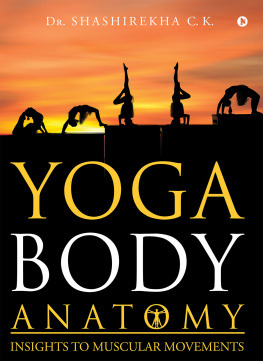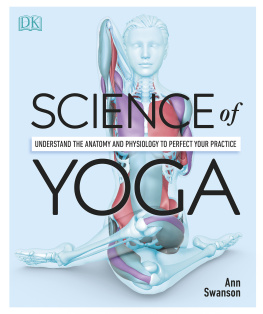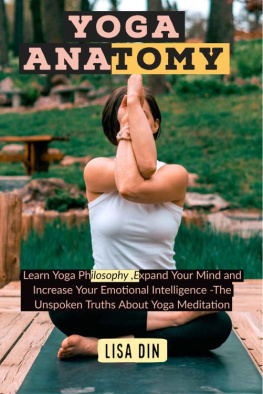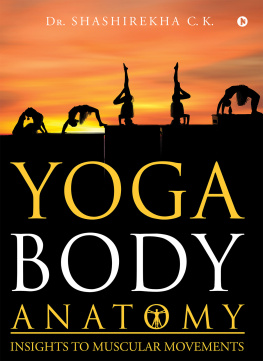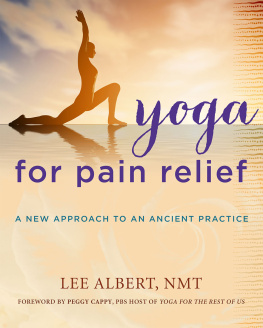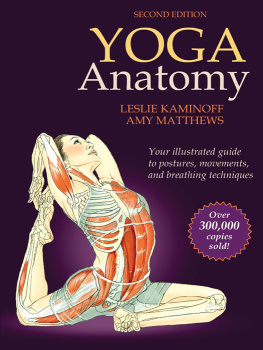YOGA
BODY
ANATOMY
INSIGHTS TO MUSCULAR MOVEMENTS
DR. SHASHIREKHA C. K.


Notion Press
Old No. 38, New No. 6
McNichols Road, Chetpet
Chennai - 600 031
First Published by Notion Press 2017
Copyright Dr. Shashirekha C. K. 2017
All Rights Reserved.
eISBN 978-1-948146-50-0
This book has been published with all reasonable efforts taken to make the material error-free after the consent of the author. No part of this book shall be used, reproduced in any manner whatsoever without written permission from the author, except in the case of brief quotations embodied in critical articles and reviews.
The Author of this book is solely responsible and liable for its content including but not limited to the views, representations, descriptions, statements, information, opinions and references [Content]. The Content of this book shall not constitute or be construed or deemed to reflect the opinion or expression of the Publisher or Editor. Neither the Publisher nor Editor endorse or approve the Content of this book or guarantee the reliability, accuracy or completeness of the Content published herein and do not make any representations or warranties of any kind, express or implied, including but not limited to the implied warranties of merchantability, fitness for a particular purpose. The Publisher and Editor shall not be liable whatsoever for any errors, omissions, whether such errors or omissions result from negligence, accident, or any other cause or claims for loss or damages of any kind, including without limitation, indirect or consequential loss or damage arising out of use, inability to use, or about the reliability, accuracy or sufficiency of the information contained in this book.
Dedicated to my parents, who guided me lovingly, shared my life with joy and enthusiasm, supported my academic and personal interests and always thought the best of me.
PREFACE
It has been 9 years since I completed my post-graduation from the most prestigious Ayurveda institution in South India, the Government Ayurveda Medical College, Mysore, Karnataka, India. I had an avid interest in the origin and influence of this healing system and took every opportunity to delve into the original ancient texts for evidence of its philosophical and intellectual connections. For example, we know from archeological evidence that Ayurveda can be traced to the ancient cities of Mohenjo-Daro and Harappa in the region known as the Indus valley. At that time, a system of healing prevailed among the people known as Aryans in which sophisticated medicines of vegetable, animal and mineral origin were used. The Rigveda, the oldest known document from the Aryan civilization, contains abundant references to plants and herbal medicines. The concept of agni and soma, the seed concepts for lateral medical theories of digestion and reproduction, are likewise used in detail in this ancient metrical scripture. The Rigveda and two other early vedas (Yajurveda and Samaveda) are distinctly ritualistic and magical, full of references to sacrifice and deities. The deities were often personifications of natural forces, such as Sun, Wind and Earth. The later text of the vedic period, the Atharvaveda, provides a much more specific and detailed view of medicine as it existed in ancient India. The detailed description of the human body is an evidence of a highly developed knowledge of anatomy.
In addition, we find a great many disease conditions delineated, including hridroga (heart diseases), kushta (leprosy), rajayakshma (tuberculosis), ashmari (kidney stones) and unmada (insanity). There is also mention of many plants used in the treatment of specific diseases. Certainly, Ayurveda has its roots in this Atharvaveda era.
Gradually, with the dawning of scientific thought, these early vedic concepts of anatomy, physiology and pharmacology were greatly expanded and developed. Finally, during the first and second centuries AD, these ideas were organized and recorded as the famous encyclopedic compendiums of Charaka and Sushrutha. Even today, these books are regarded as the main textbooks of Indian medicine. It was during this period that Ayurvedic scholars began to incorporate ideas from schools of thought other than the Samkhya doctrine that was its main affiliationone of these was the yoga school, the most celebrated and earliest texts of which is ascribed to Patanjali, a sage who lived during the end of second century AD. This school set forth the concept of the psychophysiological constitution of human beings, a system of controlling the mind and body through physical and behavioral disciplines, and methods of attaining one-pointed concentration. This latter goal could lead the aspirant to knowledge of the spirit untainted by matter.
Although it is commonly assumed that Patanjali was the founder of the yoga system, his own compendium, Yoga Sutra, states he was only the compiler and editor. The origin of the yoga system is more accurately ascribed to more ancient priest-physicians of the vedic era. The language of yoga has arisen from anatomical experimentations of various asanas on a laboratory called the human body by millions of sages over thousands of years. The system of yoga, although popularized in the West as a system of physical asanas, was originally considered medical in its purpose. The yoga system speaks about understanding diseases, its etiology, the course of the diseases and the methods to best eliminate it. This is in close agreement with the Ayurvedic approach to diseases. Clearly, Charaka (father of Indian medicine) was greatly influenced by the yoga school. Among the health-promoting measures common to yoga and Ayurveda are the use of mantras (chanting), diet, fasting, controlled breathing, relaxation, attending to natural urges in time and abstinence from excess and immoral behavior. Perhaps the most important link, however, is their common grounding in the text of the Samkhya philosophy. For example, there is a discussion in Charaka Samhita on the relationship between yoga and moksha (CS 2: 137156). Moksha is defined by Charaka as the complete annihilation of all material attachmentsmoksha nivrittirnihsesha. Chakrapani, another noted ayurvedic commentator defines moksha as absolute annihilation of the bodyatyantika sariradyucchedeh. Both these physicians identify yoga as the means of attaining this ultimate state of human liberation. Patanjali takes this idea further and provides the practical means, beginning with his second sutra: Yoga chitta vritti nirodhah (Yoga is the control of fluxes in the mind).
Today, there is a great need to clearly elucidate the therapeutic applications of yoga and its asanas. Although much is known, not much is written about the uses of asanas in the treatment of specific diseases. Among informed ayurvedic physicians interested in well-founded yoga research, the consensus is that 3 Indian institutions are conducting well-designed yoga research. Of the 3, the most respected is the Krishnamacharya Yoga Mandiram in Chennai. Other renowned institutions include the Kaivalyadhama Samithi Yogic Health Centre in Lonavia and the Sri Vivekananda Yoga Kendra in Bangalore. I personally opine that the limitations in these researches have a notable lack of correlation with modern medical understanding of diseases. Another limitation is that often the recommended asanas are beyond the ability of the individual in need, where help of some properties and preliminary exercises is needed to better accommodate the posture.
The message of yoga according to Patanjali is, Prayatna saithilyaananta sampattibhyam (YS 2:47), which means that the force and effort expended in doing asanas should be minimum. The postures are intended to be comfortable and steady (Sthiram sukham asanam, YS 2:46). The third limitation of yoga instructions is the emphasis on the achievement of a fixed, rigid form of each asana; this negates the individual constitutional differences of each practitioner and can even be injurious. Finally, the importance of breath as the key to ones yoga practice is often not emphasized enough.
Next page
